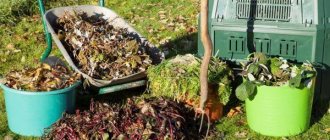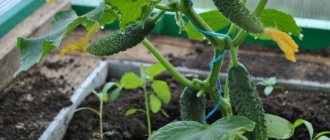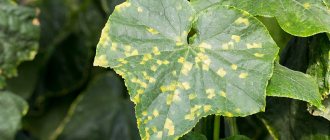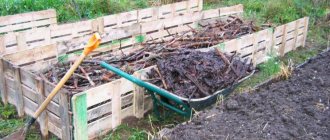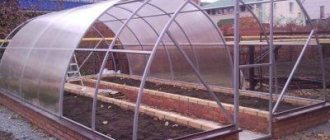Cucumber is a demanding crop in terms of moisture and soil fertility. To get a good harvest, you need properly prepared soil for planting. The crop is characterized by accelerated fruiting, therefore, already at the stage of preparing the soil for planting seeds or seedlings, it is necessary to provide it with a complex of minerals and nutrients. It is important not only to enrich the soil with nutrients, but also to saturate it with oxygen.
From the article you will learn how to prepare soil for cucumbers in a greenhouse and get an excellent harvest.
Soil requirements for growing cucumbers in a greenhouse
Cucumber is an annual herbaceous plant belonging to the pumpkin family. Like all species of this family, the cucumber has a weak root system that does not tolerate heavy soils.
Definition and structuring of soil types
The ability of soil to be divided into particles is called structure, and the multitude of particles of various sizes, shapes and qualitative compositions is called soil structure.
Main soil types:
- Clayey. They are also called heavy, they are difficult to process. Contains more than 50% clay of the total volume.
- Loamy. The composition includes from 30 to 50% clay. Loams can be heavy or light, depending on the percentage of sand particles.
- Sandy loam. Contains 10-30% clay and 90-70% sand;
- Sandy. The soil contains up to 90% sand and 10% clay.
In sandy and sandy loam soils, mechanical elements are usually in a separate-partial state. Loamy and clayey soils can be structured, structureless or poorly structured.
Determination of mechanical composition
To find out what type of soil predominates in your area, you need to determine the mechanical composition. Mechanical composition is the amount of solid particles contained in the soil.
To determine your soil type, you will need water. Take a handful of soil and moisten it to a dough-like mass. Then roll the cord 5 mm thick and roll it into a ring.
The mechanical composition of the soil is assessed by how the cord behaves:
- if the soil is sandy, then you will not be able to twist the cord;
- sandy loam soil will curl, but will immediately fall apart;
- if a ring forms but breaks up easily, then the soil is light loamy;
- on heavy loam, cracks will form when twisted;
- if the soil is clayey, then the ring will be without cracks and holds its shape well.
Loose soil with moisture-holding capacity is suitable for planting cucumbers, so sandy and clay soils are not suitable.
DO THIS WHEN PLANTING CUCUMBERS! WHAT TO PLACE IN THE HOLE!
Preparation of components for soil
To obtain maximum yield, the soil in the greenhouse must meet the following requirements:
- be breathable;
- provide heat exchange;
- when watering, get saturated with water;
- absorb all minerals when feeding;
- do not contain infections or harmful substances.
An important component of the soil is humus. Humus is rotted manure and is used as biofuel.
Important! To make soil for cucumbers, it is necessary that all components be in equal proportions, except sand. There should be the least amount of it.
To prepare humus, manure is placed in stacks, covered with peat and regularly watered with slurry. Thus, the manure is saturated with oxygen and beneficial compounds.
Humus performs important functions:
- saturates the soil with minerals;
- makes the soil looser;
- Beneficial microorganisms enter the soil along with humus.
An important component for the soil is turf. It is added to the composition to enrich the soil with nutrients and increase the soil’s ability to absorb moisture.
Attention! Sod for greenhouses is harvested from fields and meadows, preferably near marshy areas. But if horsetail grows nearby, then you should not take soil - the soil will be too acidic.
Sod harvesting takes place in two stages: the top layer of soil with the entire root system is removed, then transported to the site and mixed with manure.
Requirements for peat indicators:
- It is not recommended to use peat that is too dry, it does not shed easily;
- its humidity should not exceed 65%;
- soil acidity should be 6.5.
The use of sand in the soil increases porosity and makes the soil looser, enriching the root system of the plant with moisture and air.
As soon as all the components are prepared, they are mixed and placed in the greenhouse.
Formation of beds
The beds in a greenhouse for cucumbers are formed based on the size of the greenhouse, usually marked out in groups of 2-3. You should not make them wider than 1 meter, so as not to impede access to the plants and make caring for them easier. Special borders installed along the edge of the bed will help prevent the soil layer from being washed away when watering.
The most favorable location of beds for greenhouse plants is from west to east. In this case, the cucumbers receive maximum light throughout the day.
It is important to remember that the optimal distance between sprouts in a row should be 30 cm, between rows 25-30 cm. It is necessary to retreat at least 23-27 cm from the walls.
Based on this, the locations of future plantings are marked. Many gardeners who have greenhouses at their disposal prefer to sow seeds immediately in order to bypass the stage of “home” seedlings.
The second option is to plant ready-made seedlings. Cucumbers are planted in a greenhouse on April 14-22 at the age of 26-30 days, maintaining distances between sprouts. During the period of seedling establishment (1 week), it is advisable to increase the temperature in the greenhouse to 27°C and the humidity to 86-87%.
Cucumbers are a semi-melon crop, so both in the greenhouse and in the open ground they need raised, high beds. It is better to form them in the fall, so that the constructed embankments can form their own microclimate and their own chemo-bio-environment. Remember that the top layer of soil should be well mixed and loose. Try to lay the beds so that organic additives (especially manure) do not lie in the open air; cover them thoroughly with soil. Under the ceiling of the greenhouse, pre-stretch the wire to which you will tie the cucumber vines.
How to prepare the soil
The composition of the soil includes organic and inorganic components in certain proportions - usually 3-4 positions.
What is necessary
To prepare soil for cucumbers you need:
- turf – 30%
- humus – 30%
- peat – 30%
- sand – 10%
Step-by-step instruction
To prepare soil for growing cucumbers, follow the technology:
- Before the start of the season, clean the greenhouse. Remove all plant debris and debris.
- 25-30 days before planting cucumbers, dig up the ground.
- Prepare biomass.
- Prepare the beds.
- Plant cucumbers.
- Pour warm water over it.
Application of fertilizers
Two weeks before sowing or transplanting cucumber seedlings, fertilizers begin to be applied.
For 1 m2 of beds add:
- compost 10 kg;
- superphosphate 40 g;
- potassium sulfate 40 g;
- magnesium sulfate 15 g.
Fertilizers are applied before digging, and then the bed is watered generously. A week later, ammonium nitrate is added in an amount of 30 g. The ridge is loosened and watered again. Now the soil is ready for growing cucumbers.
Neutralization of soil in a greenhouse for cucumbers
Soil disinfection is carried out in cases where nothing has been grown in the greenhouse for a long time or, conversely, the same crop has been planted for several years in a row.
Methods for neutralizing soil in a greenhouse:
- The easiest way is to treat the soil with steam. To do this, pour boiling water over the soil and cover it with film. When exposed to high temperatures, harmful microorganisms die.
- Using copper sulfate. The solution will require 10 liters of water and 1 tbsp. l. copper sulfate. The solution is used to treat the beds in the fall, after harvesting.
- Sulfur checker. Set fire to the checker and leave it inside for an hour. After which the greenhouse is ventilated for some time.
- Bleach is a universal remedy against pests. It should be scattered on the beds.
- The use of biological products "Trichodermin" and "Fitosporin" will destroy pathogens and enrich the soil with beneficial microorganisms.
But it is not enough to neutralize just one soil; the entire greenhouse must be completely disinfected. To do this, you must first thoroughly wash the entire structure, and then wipe the windows and doors with a solution of potassium permanganate.
In what cases is it necessary to replace the soil and how to do it
Soil replacement will be required if:
- the greenhouse has been used for many years without changing the soil cover;
- in the previous season the plants were sick, there was a bad harvest;
- despite fertilizers, the plants developed poorly;
- there is an unpleasant smell coming from the ground.
In these cases you should:
- Remove plant remains.
- Remove 30 cm of old soil around the perimeter of the entire greenhouse.
- Treat the soil with copper sulfate or bleach.
- Lay fresh, prepared soil.
- Add fertilizer.
- To maintain the soil in a healthy condition, it is recommended to grow green manure.
Soil heating
Naturally, the soil in the greenhouse warms up only by June, depending on the region. In order to plant cucumbers in early spring, the greenhouse should be heated artificially.
There are three options for artificial heating of a greenhouse:
- using electrical appliances;
- water heating;
- due to warm beds.
Electrical appliances – heaters, special electrical plates, electrical cables. The advantage of this heating method is that it is possible to regulate the heat supply power; the ability to heat the greenhouse even in winter. But there are two disadvantages: the high cost of equipment and installation.
Water heating is used using special pipes made of polymer material, which are laid under the ground. Heating occurs due to hot water that flows through the pipes.
Warm beds. This heating method is the most economical. Heating of the soil occurs due to natural biofuel laid in the lower layer of the ridge. Plant remains, cardboard, manure, and sawdust are used as filler. Heat is released during the decay process and can warm the soil for two months.
Features of preparatory work
Many gardeners have a question, what kind of soil do cucumbers like? Experts believe that sandy and loamy soils are the best option. Land with a high level of acidity or heavy soils are practically unsuitable for cucumbers.
Important! The acidity level of the soil should be close to neutral. Low acidity is acceptable.
To determine whether the soil is suitable for cucumbers, you first need to determine its acidity. Ideally, for cucumbers it is necessary to use soil with an acidity level of 7. Both low and high pH have a negative effect on the growth and development of seedlings.
To correctly determine the acidity of the soil, it is better to contact a special laboratory. Here, using special equipment (Alyamovsky’s device), you can determine the acidity of the soil as accurately as possible.
If it is not possible to use the services of a laboratory, you can try to determine the pH level yourself, focusing on the weeds that grow on the site. For example, if woodlice, heather, horsetail or sorrel grow on the site, this indicates that the soil acidity level in this area is close to 7. If clover, bindweed or chamomile predominate on the site, this means that the soil is neutral alkaline.
Proper soil preparation is the key to a good harvest.
You can reduce soil acidity by using lime. This method is considered effective and inexpensive by gardeners.
When planting cucumber seedlings in a polycarbonate greenhouse, not only the composition of the soil is important, but also the temperature and humidity. The indoor air temperature should be between 22 - 29 degrees.
Important! During the period of fruit formation and development, the air temperature in the greenhouse should not exceed 25 degrees.
Before starting sowing work, the soil should be disinfected. To do this, use a weak solution of potassium permanganate, which is carefully watered over the top layer of soil. Before processing, it is necessary to remove the top 20 cm of soil.
General recommendations for preparing soil for cucumbers and caring for them
General soil requirements for growing cucumbers:
- the soil should be loose, saturated with oxygen;
- contain a large amount of organic and mineral matter;
- have an acidity level of 6.2-6.5;
- the soil should not contain infections and harmful microorganisms.
Proper soil care is as follows:
- To prevent the soil from drying out, regular watering is required;
- the application of mineral fertilizers helps enrich the soil with nutrients;
- creating a favorable microclimate inside the greenhouse to avoid excessive soil moisture;
- Regular ventilation of the greenhouse to prevent fungal diseases.
Acidity regulation
Acidic soil is typical for low-lying areas with stagnant spring water. Acidity can also increase after seasons with increased rainfall, which wash away calcium and magnesium. Hydrogen ions begin to predominate in soil particles, increasing its acidity.
In such areas, plantain, wild rosemary, horsetail, speedwell and sorrel grow rapidly. When digging up the soil at a depth of 10-15 cm, you can find a light-colored layer resembling ash.
The easiest and most inexpensive way to determine soil acidity is to use litmus paper. It can be purchased at any garden store and pharmacies.
To determine the acidity of the soil, mix a semi-liquid solution of soil and distilled water, and immerse a strip of litmus paper in it for 2-3 seconds. To calculate acidity values, it is compared with the accompanying color scale.
Calcium carbonate is used to reduce soil acidity. It is found in ground limestone, chalk, cement dust, wood ash, dolomite and bone meal.
For the primary regulation of acidity, it is better to use ground limestone. Norms for its application per 1 sq. m. for various soil types (pH {amp}lt; 4.5/ pH 4.6-6.0):
- sand 400/100 g;
- sandy loam 600/150 g;
- loamy 800/350 g;
- aluminas 1100/500 g;
- peat-swampy 1400/300 g.
Cucumbers are very sensitive to liming, so measures to reduce soil acidity are best carried out under the previous crop. As a last resort - in the fall.
In the future, to maintain acidity at the required level, wood ash is used, which also serves as a good fertilizer.
